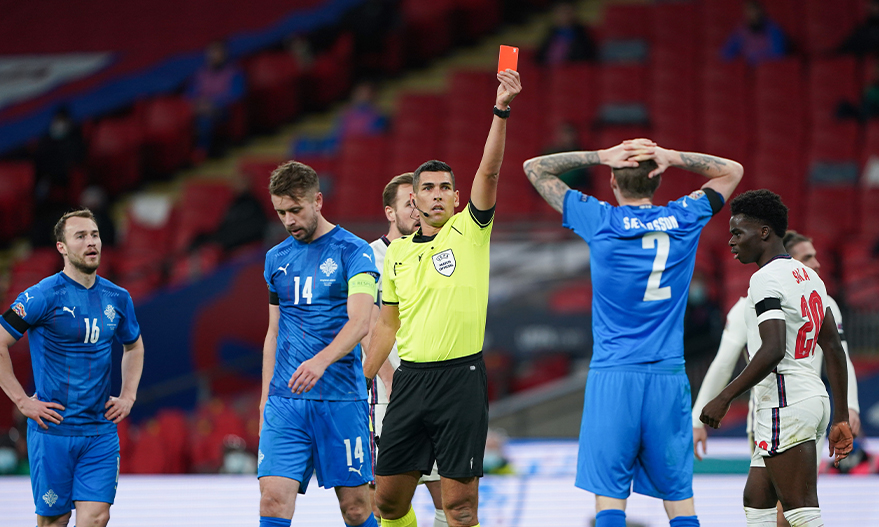
Seeing red: how to succeed with – or against – a team of 10
- The Boot Room
- 18 June 2021
During the 2020/21 season, one in nine Premier League games included a red card. But how did the affected teams react and what does this mean for your coaching?
If you lose a player in top-flight football, chances are it’ll happen around the 60th minute. This means that, following a red card, teams usually play at least a third of their match at a disadvantage – or advantage.
The perfect example of this is Grzegorz Krychowiak’s red card against Slovakia during Euro 2020. The Polish midfielder received his second yellow in the 62nd minute and, incidentally, the match was the ninth game of the tournament. Post sending-off, Poland failed to recover and Slovakia went on to win 2-1.
While losing a player is less common in lower age groups, it's still important to consider the impact and work with your team to prepare them for the adult game. Here, we explore insight from the 2020/21 Premier League and discuss what it means for your practice design.
PLAYING WITH 10
First up, some good news. Our analysis of the Premier League shows that, if you're already winning when your team go down to 10, you'll probably hang on to your lead. Take Newcastle United, who retained their 3-2 advantage after losing a man against Southhampton in February 2021.
However, if you're trailing – or drawing – it's very likely that you'll go on to lose the game. In fact, last season, not a single Premier League team with 10 players was able to come from behind and win their match.
But what happens when the boot is on the other foot; is having more players all it’s cracked up to be?
PLAYING AGAINST 10 Unsurprisingly, the stats show that if a team is ahead when their opposition loses a player, they almost always protect their lead. We saw this in October 2020 when Tottenham, who were already winning 2-1, finished the game 6-1 against a 10-man Manchester United.
However, if a team is drawing or losing when their opposition goes down to 10, things are a little less promising...
If the scores are equal, the team with more players only wins 41% percent of the time. This means that, on more than half of all occasions, they don’t take effective advantage of their increased numbers.
For teams who are losing, the picture is even grimmer. Last season, the number of Premier League teams who came from behind to win against a team of 10 was... zero.
So, how can you help your players beat the odds?
PRACTICE DESIGN TIPS Whether you’re preparing your team to succeed with or against 10, the advice is very similar. Here are our top tips.
1. Create overloads and underloads
By their very nature, red cards create uneven games. In losing a player, the affected team becomes ‘overloaded’ by the opposition. And, in turn, the opposition becomes ‘underloaded’.
Re-creating this type of uneven play is a great way to prepare your team to deal with a red card. One option is to use small-sided games with overloads or underloads built in – e.g. 5v3 or 2v4. Another option is to use parallel games and regularly switch players between pitches. This creates uneven teams that fluctuate over time and can help players adapt to sudden overloads or underloads.
2. Practice keeping possession
If your team get a red card, it’s likely that their rate of possession will fall. On the other hand, if you’re playing against a team who go down to 10, your rate of possession will probably go up. In both instances, players need to know how to protect and keep the ball. These sessions can help: Building to a game and Individual and combination play.
3. Don’t wait for a booking
As we’ve mentioned, red cards are less common in grassroots football, but don’t wait for a booking to try out a different formation. Instead, use your matches and sessions to regularly expose players to different set-ups and positions.
4. Talk to your players
After a red card, it can be easy to lose momentum and adopt a very defensive style of play. But is this what your team want? If you speak to your players, you may find they’d prefer to continue to attack – and that's fine. Part of being a good coach is giving your team the freedom to make their own decisions.
5. Keep it real
If you want players to cope with the demands of a match, they need to practise in a realistic environment. So, make sure your players get the chance to manage overloads and underloads while defending and attacking a goal. This directional, invasion-based play is the foundation of football.
SUMMARY While red cards may not feature heavily in your matches, there’s still value in preparing your players to face them. What’s more, a lot of the tips here are simply great coaching advice. Exploring underloads and overloads, creating small-sided, realistic games and talking to your players are all great ways to develop your team.


